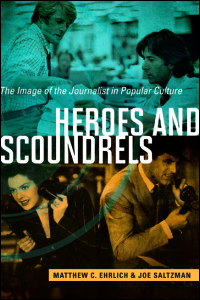
Heroes and Scoundrels:
The Image of the Journalist in Popular Culture

By Matthew C. Ehrlich
Professor of journalism at the
University of Illinois at Urbana-Champaign
and
Joe Saltzman
Professor of journalism and communication
at the University of Southern California
Publication date: April 2015. University of Illinois Press
Professionalism
Chapter Two
One of modern journalism’s hallmarks was the rise of professionalism. In the face of yellow news and jazz news, journalists sought to promote respectability by putting their occupation on par with professions such as law and medicine. Particularly in the United States, the first decades of the twentieth century saw the development of journalism schools, so-called objective reporting, and professional organizations with ethics codes. By the era of “high modernism” following World War II, “providing citizens with accurate, ‘unbiased’ information about public affairs” had become the press’s chief goal.1 However, journalistic professionalism started to come under fire by the 1960s and 1970s, with charges that it diminished public life and encouraged passive reporting.
Here we examine how popular culture has portrayed professionalism’s key tenets. Our look at recurring types such as the cub reporter, the investigative reporter, and the editor will show that pop culture reinforces many of the critiques of professionalism—hard, cold reality trumps principles taught in school; reportorial objectivity is difficult to achieve; and ethical choices are fraught with unforeseen consequences. On the other hand, good and responsible journalism is consistently celebrated, whereas bad and irresponsible journalism is excoriated.
Ehrlich-Saltzman, Heroes and Scoundrels: The Image of the Journalist in Popular Culture – page 39. ©University of Illinois Press, 2015
In sum, popular culture shows a press that has had more than its share of shameful failings and black eyes and yet still is principled and virtuous when it counts the most. Either way, journalism is exciting and important, an image not far removed from journalism’s fondest self-conceptions. According to journalism scholar Michael Schudson, many people “look at the press and see Superman when it’s really just Clark Kent.” Critics of professionalism might respond that that is precisely the problem with mainstream journalism: it is entirely too meek and mild-mannered. In popular culture that is not an issue. There, journalists (even Clark Kent at times) do thrilling and wondrous things, and if those things do not always coincide with the tidy image that professional journalism organizations have promoted over the years, they may be more likely to stir the imagination and stoke the flames.
Ehrlich-Saltzman, Heroes and Scoundrels: The Image of the Journalist in Popular Culture – page 57. ©University of Illinois Press, 2015
No popular culture character has been more devoted to bringing bad guys to justice than Superman. His alter ego, Clark Kent, is a journalist for the Daily Planet (and sometimes for TV news and the Internet as well), and he displays a complex relationship to journalistic professionalism. At times he can be a very good reporter, yet he also highlights the potential problems with objectivity and the murky ethics surrounding journalistic deception.
Ehrlich-Saltzman, Heroes and Scoundrels: The Image of the Journalist in Popular Culture – page 48. ©University of Illinois Press, 2015.
This chapter also includes: Cub Reporters and the Education of Journalists, Investigative Reporters and the Pursuit of Truth, and Editors for Better or Worse.
Other Resources:
New Films to include:
Spotlight, The Post
Matthew C. Ehrlich, “Thinking about Journalism with Superman,” IJPC Journal 4 (Fall 2012-Spring 2013): 132–63, http://ijpc.uscannenberg.org/journal/index.php/ijpcjournal/article/view/34/62 - PDF
Hollywood & Journalistic Truthtelling:http://ijpc.org/uploads/files/Ehrlich%20Hollywood%20and%20Journalistic%20Truthtelling.pdf
Facts, Truth and Bad Journalists in the Movies by Matthew C. Ehrlich in Journalism, Vol. 7, No. 4, 501-519 (2006) © Sage Publications 2006.
The Wire and Repair of the Journalistic Paradigm by Linda Steiner, Jing Guo, Raymond McCaffrey and Paul Hills, Journalism 2013 14:703
Check out the other chapters: